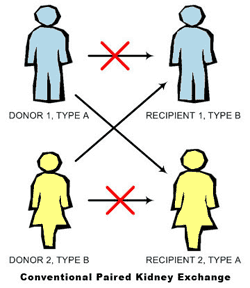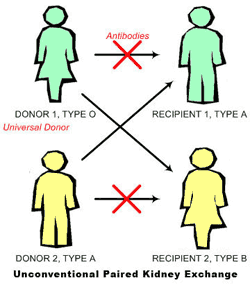Guide to Living Donor Kidney Transplants
On Page Nav:
Reviewed by the physicians of Columbia’s Kidney Transplant Team (December, 2023)
The first successful live donor kidney transplant was performed in 1954. The donor and recipient were identical twins. Since then, our understanding of donor compatibility and the development of immunosuppressant medications have greatly advanced living donor procedures. Today, approximately 75% of people who receive a kidney transplant from a living donor maintain their kidney function for 10 to 20 years.
Living donor programs allow a relative or a compatible unrelated donor (such as a spouse or friend) to donate a kidney. Siblings have a 25% chance of being an "exact match" for a living donor and a 50% chance of being a "half-match." Donor compatibility is established through blood tests that look for matching blood types and antigens. The overall health of the potential donor is also of critical importance. (To learn more about becoming a donor, please click here.)
Kidneys from perfectly matched sibling donors on average can function for over 35 years. Live donor procedures of all types, however, offer better outcomes than deceased donor procedures:
- Live donor recipients spend less time waiting for a donor organ. The wait for a deceased donor kidney in New York averages five to seven years.
- Immediately upon transplantation, 97% of live donor kidneys are fully functional, versus 50-60% of deceased donor kidneys.
- Live donor recipients face less risk of organ rejection.
The success of the living donor program has helped to make renal transplantation one of the most common and successful types of organ transplantation. NewYork-Presbyterian/Columbia University Irving Medical Center (NYP/Columbia) began performing live donor kidney transplants in 1970 and expanded its program in 1986 to encompass non-related donors. Today, NYP/Columbia has the most active living-donor service in New York.
Incompatible Living Donor Transplant
Ideally, to be eligible for transplantation, kidney donors and recipients should have compatible blood and tissue types. Too often, however, willing live donors do not meet these medical criteria. While it remains preferable (safer, easier, and less expensive) to receive a kidney from someone who is fully immunologically compatible, recipients can be successfully transplanted from a donor with mismatched antibodies.
When antibodies are present, the blood of the recipient and donor react to each other, much like an allergic reaction. In the past, this reaction has caused the recipient's body to reject the donor organ. Today, we can successfully transplant from an incompatible donor if the recipient's blood is first "cleaned" of antibodies through a process known as plasmapheresis.
First, the amount of antibodies present must be quantified. This level helps to determine the number of treatments required. Next, the recipient's blood is separated into cells and plasma (liquid). The plasma is removed and replaced with a commercially available plasma substitute. Removing the plasma removes the antibodies. In essence, plasmapheresis is similar to dialysis; it removes antibodies just as dialysis removes waste products.
Depending on the level of antibodies present, plasmapheresis may be performed anywhere from 2-10 times. Most patients receive the treatment every other day, for up to three times a week. Once the quantity of antibodies drops to a low enough level, the recipient can undergo the transplant.
Paired Donor Exchange
The field of kidney transplant surgery is evolving in dramatic ways thanks to the advent of paired exchanges, or ‘kidney swaps.’ During a kidney swap, transplant recipients who have willing live donors essentially swaps donor organs. For patients who have a willing but incompatible donor, the strategy allows people who need a kidney to receive an organ that is a better match to his or her blood type and antibodies than their own donor could provide. The success of such exchanges has given rise to transplants among up to six donor-recipient pairs at the Kidney and Pancreas Transplant Program at NYP/Columbia. And when hospitals across regions coordinate efforts, they are able to organize even larger swaps like the recent swap involving 30 donors, 30 recipients, and 17 hospitals across the U.S. over a four-month period.


How a Paired Exchange (Kidney Swap) Works
In a paired donor exchange, also known as a kidney swap, two kidney recipients essentially "swap" willing donors. While medically eligible to donate, each donor has an incompatible blood type or antigens to his or her intended recipient. By agreeing to exchange recipients—giving the kidney to an unknown, but compatible individual—the donors can provide two patients with healthy kidneys where previously no transplant would have been possible.
The goal of a paired donor exchange is to make optimal use of willing live donors, while helping potential recipients off the transplant waiting-list and back to leading productive lives. Only a handful of kidney swaps, including swaps involving up to three sets of donor-recipients, have been performed nationwide to date. The Incompatible Kidney Transplant Program at NewYork-Presbyterian/Columbia University Irving Medical Center is one of the few select programs that perform this procedure.
A range of safeguards are in place to ensure fair exchanges. Prior to their operations, the two pairs remain anonymous, to avoid undue pressure on the donors. Both donors must undergo anesthesia and surgery simultaneously, preventing a single individual from backing out at the last minute, leaving one recipient without a donated organ.
As with the donor procedures, the transplant operations are performed at the same time. This poses a substantial logistical and staffing challenge. Four operating rooms must be available at once, as well as four complete surgical teams to staff those rooms. As a large academic medical center, NewYork-Presbyterian/Columbia has the resources and ability to undertake such a challenge.
Transplant Procedure
The transplant procedure is the same for all types of living donor transplants, and involves safely removing a healthy kidney from a donor and implanting it into the recipient. These surgeries must be coordinated to ensure that the donor organs remain viable.
Living donor organs are obtained using a laparoscopic nephrectomy, a minimally invasive procedure that typically requires three half-inch incisions to free the kidney, which is then removed from the patient through a slightly larger incision. The removed donor kidney is placed on ice until it can be implanted in the recipient.
Once the surgeon has obtained the donor kidney, they make a 4-10 inch incision to place the kidney on one side of the recipient's front lower abdomen. Some patients may be candidates for a new minimal access kidney transplant procedure. The procedure, which we developed at Columbia, uses a single three-inch incision. The novel placement of the kidneys—versus its natural position at the back of the body—allows the surgeon to more easily connect the kidney to the bladder. To ensure an adequate blood supply, the surgeon also attaches the kidney to an artery and vein that lead to the legs. In most cases, the patient's own kidneys are not removed, thereby avoiding unnecessary additional surgery.
The transplant operation typically lasts from 2½-5 hours. The patient stays in the hospital for as little as three days and spends approximately six weeks recuperating at home. All organ transplant recipients, including kidney recipients, need to take daily immunosuppressant medications.
Next Steps
If you are interested in participating in a paired donor exchange or becoming a living kidney donor, we can help. Call us at (212) 305-6469 to get started today, or sign up with one of our online forms: I Need A Transplant » | I Want to Donate My Kidney »
Related Topics
- Kidney Transplant Surgery
- End Stage Kidney Disease
- Pancreas Transplants
- Facts About Organ Donation
- Becoming a Kidney Donor
Stories & Perspectives
Firefighter Is Key to Historic Three-Way Kidney Swap
Kidney swaps enable incompatible donors to give to strangers, in return for a matched kidney that can help their own loved ones or family members. The chain of giving can start with a single altruistic donor. Thirty-nine-year-old Long Island firefighter John McGuinness recently became the lynchpin in a rare three-way kidney swap, performed at NewYork-Presbyterian/Columbia.
Related Resources
- Transplant Evaluation Questionnaire
- Living Donor Evaluation Questionnaire
- Your Kidney Transplant
- Follow-Up Visits After Kidney Transplant Surgery
- Resuming Life After Kidney Transplantation
- Organ Rejection after Kidney Transplant
- Nutrition After Kidney Transplant
- Immunosuppressant Medications
- Infection After Kidney Transplant
